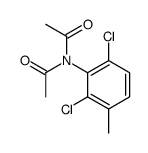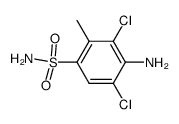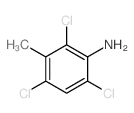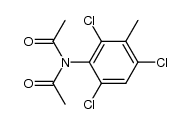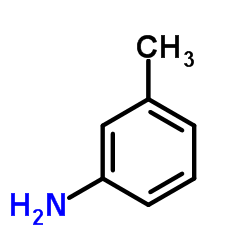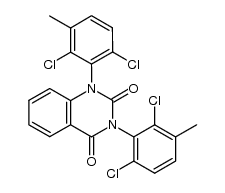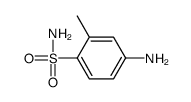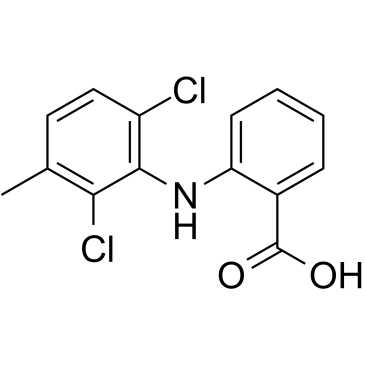64063-37-2
| 中文名 | 2,6-二氯间甲苯胺 |
|---|---|
| 英文名 | 2,6-Dichloro-3-methylaniline |
| 中文别名 |
2,6-二氯对三氟甲基苯胺
2,6-二氯-3-甲基苯胺 2,6-二氯-3-甲基苯胺 |
| 英文别名 |
2, 6-Dichloro-3-Methylaniline
2,5-DIAMINO-N-(2-CHLOROPHENYL)BENZENESULFONAMIDE Benzenamine,2,6-dichloro-3-methyl 2,6-dichloro-3-methylphenylamine 2,6-dichloro-3-methyl-aniline 2,6-Dichloro-3-methylaniline Benzenamine, 2,6-dichloro-3-methyl- 2,6-dichlor-3-methylanilin MFCD00007676 2,6-Dichloro-3-methylbenzenamine 2,6-dichloro-3-methyl-benzenamine 2,6-dichloro-m-toluidine EINECS 264-649-3 |
| 密度 | 1.3±0.1 g/cm3 |
|---|---|
| 沸点 | 241.1±35.0 °C at 760 mmHg |
| 熔点 | 37-40 °C |
| 分子式 | C7H7Cl2N |
| 分子量 | 176.043 |
| 闪点 | 99.6±25.9 °C |
| 精确质量 | 174.995560 |
| PSA | 26.02000 |
| LogP | 3.36 |
| 外观性状 | 白色粉末 |
| 蒸汽压 | 0.0±0.5 mmHg at 25°C |
| 折射率 | 1.600 |
| 储存条件 | 密闭于阴凉干燥环境中 |
| 稳定性 | 遵照规定使用和储存则不会分解。 |
| 水溶解性 | insoluble |
| 分子结构 | 1、 摩尔折射率:45.10 2、 摩尔体积(m3/mol):131.8 3、 等张比容(90.2K):342.4 4、 表面张力(dyne/cm):45.4 5、 极化率(10-24cm3):17.88 |
| 计算化学 | 1.疏水参数计算参考值(XlogP):2.9 2.氢键供体数量:1 3.氢键受体数量:1 4.可旋转化学键数量:0 5.互变异构体数量:无 6.拓扑分子极性表面积26 7.重原子数量:10 8.表面电荷:0 9.复杂度:118 10.同位素原子数量:0 11.确定原子立构中心数量:0 12.不确定原子立构中心数量:0 13.确定化学键立构中心数量:0 14.不确定化学键立构中心数量:0 15.共价键单元数量:1 |
| 更多 | 1. 性状:针状结晶 2. 密度(g/mL,25/4℃):无可用 3. 相对蒸汽密度(g/mL,空气=1):无可用 4. 熔点(ºC):37-39 5. 沸点(ºC,常压):无可用 6. 沸点(ºC,5.2kPa):无可用 7. 折射率:无可用 8. 闪点(ºC):>110 9. 比旋光度(º):无可用 10. 自燃点或引燃温度(ºC):无可用 11. 蒸气压(kPa,25ºC):无可用 12. 饱和蒸气压(kPa,60ºC):无可用 13. 燃烧热(KJ/mol):无可用 14. 临界温度(ºC):无可用 15. 临界压力(KPa):无可用 16. 油水(辛醇/水)分配系数的对数值:无可用 17. 爆炸上限(%,V/V):无可用 18. 爆炸下限(%,V/V):无可用 19. 溶解性:无可用 |
Synonym:None known Section 2 - COMPOSITION, INFORMATION ON INGREDIENTS
Risk Phrases: None Listed. Section 3 - HAZARDS IDENTIFICATION EMERGENCY OVERVIEW
The toxicological properties of this material have not been fully investigated. Potential Health Effects Eye: May cause eye irritation. Skin: May cause skin irritation. Ingestion: May cause irritation of the digestive tract. The toxicological properties of this substance have not been fully investigated. Methemoglobinemia is characterized by dizziness, drowsiness, headache, shortness of breath, cyanosis (bluish discoloration of skin due to deficient oxygenation of the blood), rapid heart rate and chocolate-brown colored blood. Overexposure may cause methemoglobinemia. Inhalation: May cause respiratory tract irritation. The toxicological properties of this substance have not been fully investigated. Methemoglobinemia is characterized by dizziness, drowsiness, headache, shortness of breath, cyanosis (bluish discoloration of skin due to deficient oxygenation of the blood), rapid heart rate and chocolate-brown blood. Inhalation of aniline causes anoxia due to the formation of methemoglobin. Chronic: May cause methemoglobinemia, which is characterized by chocolate-brown colored blood, headache, weakness, dizziness, breath shortness, cyanosis (bluish skin due to deficient oxygenation of blood), rapid heart rate, unconsciousness and possible death. Section 4 - FIRST AID MEASURES Eyes: Flush eyes with plenty of water for at least 15 minutes, occasionally lifting the upper and lower eyelids. Get medical aid. Skin: Get medical aid. Flush skin with plenty of water for at least 15 minutes while removing contaminated clothing and shoes. Wash clothing before reuse. Ingestion: Never give anything by mouth to an unconscious person. Get medical aid. Do NOT induce vomiting. If conscious and alert, rinse mouth and drink 2-4 cupfuls of milk or water. Inhalation: Remove from exposure and move to fresh air immediately. If not breathing, give artificial respiration. If breathing is difficult, give oxygen. Get medical aid. Do NOT use mouth-to-mouth resuscitation. Notes to Physician: For methemoglobinemia, administer oxygen alone or with Methylene Blue depending on the methemoglobin concentration in the blood. Antidote: Methylene blue, alone or in combination with oxygen is indicated as a treatment in nitrite induced methemoglobinemia. Section 5 - FIRE FIGHTING MEASURES General Information: As in any fire, wear a self-contained breathing apparatus in pressure-demand, MSHA/NIOSH (approved or equivalent), and full protective gear. During a fire, irritating and highly toxic gases may be generated by thermal decomposition or combustion. Extinguishing Media: Use agent most appropriate to extinguish fire. Use water spray, dry chemical, carbon dioxide, or appropriate foam. Section 6 - ACCIDENTAL RELEASE MEASURES General Information: Use proper personal protective equipment as indicated in Section 8. Spills/Leaks: Clean up spills immediately, observing precautions in the Protective Equipment section. Sweep up, then place into a suitable container for disposal. Avoid generating dusty conditions. Provide ventilation. Section 7 - HANDLING and STORAGE Handling: Wash thoroughly after handling. Remove contaminated clothing and wash before reuse. Use with adequate ventilation. Minimize dust generation and accumulation. Avoid contact with eyes, skin, and clothing. Keep container tightly closed. Avoid ingestion and inhalation. Storage: Store in a tightly closed container. Store in a cool, dry, well-ventilated area away from incompatible substances. Section 8 - EXPOSURE CONTROLS, PERSONAL PROTECTION Engineering Controls: Facilities storing or utilizing this material should be equipped with an eyewash facility and a safety shower. Use adequate ventilation to keep airborne concentrations low. Exposure Limits CAS# 64063-37-2: Personal Protective Equipment Eyes: Wear appropriate protective eyeglasses or chemical safety goggles as described by OSHA's eye and face protection regulations in 29 CFR 1910.133 or European Standard EN166. Skin: Wear appropriate protective gloves to prevent skin exposure. Clothing: Wear appropriate protective clothing to prevent skin exposure. Respirators: A respiratory protection program that meets OSHA's 29 CFR 1910.134 and ANSI Z88.2 requirements or European Standard EN 149 must be followed whenever workplace conditions warrant respirator use. Section 9 - PHYSICAL AND CHEMICAL PROPERTIES Physical State: Powder Color: white Odor: None reported. pH: Not available. Vapor Pressure: Not available. Viscosity: Not available. Boiling Point: Not available. Freezing/Melting Point: 37.00 - 39.00 deg C Autoignition Temperature: Not applicable. Flash Point: > 110 deg C (> 230.00 deg F) Explosion Limits, lower: Not available. Explosion Limits, upper: Not available. Decomposition Temperature: Solubility in water: insoluble Specific Gravity/Density: Molecular Formula: C7H7Cl2N Molecular Weight: 176.04 Section 10 - STABILITY AND REACTIVITY Chemical Stability: Stable under normal temperatures and pressures. Conditions to Avoid: Incompatible materials, dust generation, excess heat, strong oxidants. Incompatibilities with Other Materials: Oxidizing agents. Hazardous Decomposition Products: Hydrogen chloride, nitrogen oxides, carbon monoxide, irritating and toxic fumes and gases, carbon dioxide, nitrogen. Hazardous Polymerization: Has not been reported. Section 11 - TOXICOLOGICAL INFORMATION RTECS#: CAS# 64063-37-2 unlisted. LD50/LC50: Not available. Not available. Carcinogenicity: 2,6-Dichloro-3-Methylaniline - Not listed by ACGIH, IARC, or NTP. Section 12 - ECOLOGICAL INFORMATION Section 13 - DISPOSAL CONSIDERATIONS Dispose of in a manner consistent with federal, state, and local regulations. Section 14 - TRANSPORT INFORMATION IATA Not regulated as a hazardous material. IMO Not regulated as a hazardous material. RID/ADR Not regulated as a hazardous material. Section 15 - REGULATORY INFORMATION European/International Regulations European Labeling in Accordance with EC Directives Hazard Symbols: Not available. Risk Phrases: Safety Phrases: S 24/25 Avoid contact with skin and eyes. S 28A After contact with skin, wash immediately with plenty of water. S 37 Wear suitable gloves. S 45 In case of accident or if you feel unwell, seek medical advice immediately (show the label where possible). WGK (Water Danger/Protection) CAS# 64063-37-2: No information available. Canada CAS# 64063-37-2 is listed on Canada's NDSL List. CAS# 64063-37-2 is not listed on Canada's Ingredient Disclosure List. US FEDERAL TSCA CAS# 64063-37-2 is listed on the TSCA inventory. SECTION 16 - ADDITIONAL INFORMATION N/A |
|
生态学数据: 该物质对环境可能有危害,对水体应给予特别注意。
|
| 危害码 (欧洲) | Xn:Harmful; |
|---|---|
| 风险声明 (欧洲) | R22;R36/37/38 |
| 安全声明 (欧洲) | S37/39-S26 |
|
~92% 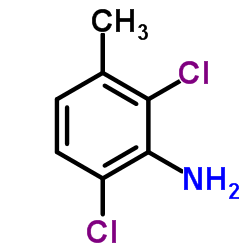
64063-37-2 |
| 文献:Pews; Hunter; Wehrmeyer Tetrahedron, 1993 , vol. 49, # 22 p. 4809 - 4820 |
|
~86% 
64063-37-2 |
| 文献:McKendry; Stanga Journal of Labelled Compounds and Radiopharmaceuticals, 1994 , vol. 34, # 12 p. 1157 - 1164 |
|
~% 
64063-37-2 |
| 文献:Tetrahedron, , vol. 49, # 22 p. 4809 - 4820 |
|
~% 
64063-37-2 |
| 文献:Tetrahedron, , vol. 49, # 22 p. 4809 - 4820 |
|
~% 
64063-37-2 |
| 文献:US5068392 A1, ; |
|
~% 
64063-37-2 |
| 文献:Tetrahedron, , vol. 49, # 22 p. 4809 - 4820 |
|
~% 
64063-37-2 |
| 文献:Journal of Medicinal Chemistry, , vol. 11, # 1 p. 111 - 117 |
|
~% 
64063-37-2 |
| 文献:Journal of the Chemical Society, , p. 1208,1212 |


